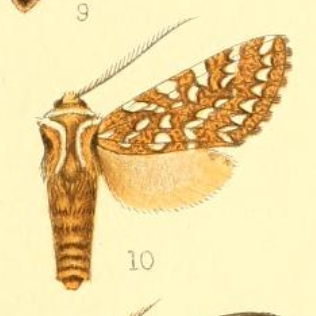Episcepsis is a genus of tiger moths in the family Erebidae. The genus was erected by Arthur Gardiner Butler in 1877.
Hellinsia sematias is a moth of the family Pterophoridae. It is found in Sri Lanka and India.
Repnoa is a genus of moths in the family Megalopygidae. It contains only one species, Repnoa imparilis, which is found in French Guiana.
Eochroma is a genus of moths in the family Megalopygidae. It contains only one species, Eochroma pulchella, which is found in French Guiana.

Lophocampa andensis is a moth in the family Erebidae. It was described by Schaus in 1896. It is found in Colombia.
Episcepsis gnomoides is a moth of the family Erebidae. It was described by William Schaus in 1910. It is found in Costa Rica.
Episcepsis lamia is a moth of the family Erebidae. It was described by Arthur Gardiner Butler in 1877. It is found in the Amazon region, Guatemala and Costa Rica.

Episcepsis venata is a moth of the family Erebidae. It was described by Arthur Gardiner Butler in 1877. It is found in Mexico and the Amazon region.

Episcepsis sixola is a moth of the family Erebidae. It was described by William Schaus in 1910. It is found in Costa Rica.

Spilosoma crossi is a moth in the family Erebidae. It was described by Rothschild in 1910. It is found in Nigeria and Gambia.
Langsdorfia coresa is a moth in the family Cossidae. It was described by William Schaus in 1901 and is found in Colombia.
Euphalacra nigridorsata is a moth in the family Drepanidae. It was described by Warren in 1897. It is found in the north-eastern Himalayas.
Nordstromia humerata is a moth in the family Drepanidae. It was described by Warren in 1896. It is found in north-eastern India.
Cryptolechia transfossa is a moth in the family Depressariidae. It was described by Edward Meyrick in 1926. It is found in Peru.
Agonopterix rubristricta is a moth in the family Depressariidae. It was described by Walsingham in 1912. It is found in Guatemala.
Mecistoptera albisigna is a species of moth of the family Erebidae. It was described by George Hampson in 1912. It is found in southern India, Australia and on Fiji.
Hypatima lactifera is a moth in the family Gelechiidae. It was described by Edward Meyrick in 1913. It is found in Assam, India.
Hypatima euplecta is a species of moth in the family Gelechiidae. It was described by Edward Meyrick in 1904. It is found in Australia, where it has been recorded from Queensland, New South Wales, Victoria and South Australia.
Megalopyge torva is a moth of the family Megalopygidae. It was described by Schaus in 1912. It is found in Costa Rica.
Mesoscia lorna is a moth of the family Megalopygidae. It was described by William Schaus in 1905. It is found in French Guiana.



